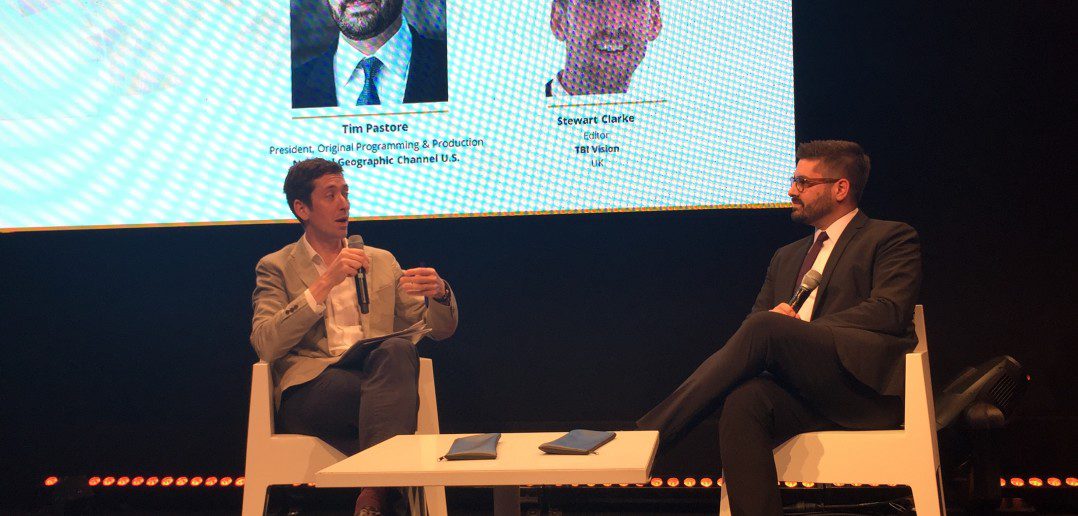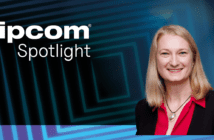Tim Pastore, President, Original Programming & Production, National Geographic Channels US (right), gave MIPDoc 2015’s first keynote today, in a session moderated by TBI Vision’s Stewart Clarke.
What could possibly be more important than content in the eyes of National Geographic’s Tim Pastore? The answer he gave at MIPDoc today was metaphoric: « If content is king, the brand is the castle. Kings come and go; the castle stays. » The older the brand, the bigger the stakes, according to the executive: National Geographic is 127 years in the making, and Pastore reminded the audience that he « was raised in towers of yellow magazines. » So, what’s next for the worldwide-known brand that has successfully launched several channels in the past decades, and is now facing disruption from all parts? « To survive, we need to actualise the power of our brand: habits have changed dramatically in the past few years. Brand plays a more significant role than ever before. There’s a hurricane of content crashing into our homes, » Pastore added.
« We’re in 2015, and 50% of viewers are doing something else whilst watching TV », said Pastore. As such, being present on social media isn’t just an option anymore. To survive in this « hurricane », National Geographic can count on its 50 millions fans and its 15 Instagram followers.
But the company’s long-term strategy relies on 5 strong pillars, Pastore explained:
Stay bold: this dates back to the times National Geographic made its first shows, including 1965’s American on Everest, which became a landmark;
Be resilient: Pastore believes that a brand is capable of evolving to remain relevant, with its anthem for instance. National Geographic’s iconic 1980s theme now belongs to the past! « The audience will repay you for staying true to your core » though, he added, insisting on what makes the brand unique, and mentioning the relaunch of « Explorer » shows that still « bring National Geographic magazine stories to life. »
Maintain authenticity: this does not mean that the brand should be boring, but rather that it must retain « a point of view & not be swept away by trends. » « Do we need another Alaska series? » Pastore asked, further explaining that he will accept a new project only if it’s compelling and true to the National Geographic brand. Their second highest rating show in recent years is Super Modern, a series that definitely « breaks through the clutter » whilst staying true to the brand.
Make some noise: creating buzz, notably on social media, is crucial for a brand like National Geographic, said Pastore. He took the example of Killing Jesus — one of NatGeo’s first scripted drama shows — which notably features second screen experiences. « There have been 1 million impressions for the Killing Jesus minisite, making it our best-performing digital property. » Authencity remains key, even after all these experiments and innovations, for « the power of a brand is that it bring the viewers back home when they’re lost, » concluded Pastore.
Disrupt: « You need to let go of the fear of being trapped by your own expectations, » Pastore told the MIPDoc audience. The only relevant question is: how can you turn disruption into programming? He mentioned National Geographic’s first comedy, History of the World… For Now (written by the talent behind Silicon Valley & King of the Hill).
[youtube]https://www.youtube.com/watch?v=SnAI6AK9X2Y[/youtube]
Then it was on to a quick-fire Q&A session with Stewart Clarke.
Clarke: Is the brand a much bigger, broader thing than ever before?
Pastore: The yellow border is the lense through which we look at the world. History of the World is our latest attempt to broaden our scope, and also to make our brand more modern and current, and bring in a new fanbase for the future.
> Can a shift like this one be an opportunity to attract more women?
Absolutely. Even if National Geographic will always be slightly more male-skewing, we don’t want it to be 70-30.
> Is smart entertainment/edutainment reaching the end of its wave?
Brain Games was lightning in a bottle. The future of that strand of programming lies in broadening it.
> Killing Jesus attracted an audience of 3.7 million. What can we expect moving forwards in drama?
We’re looking to delve into a couple of projects a year, and maybe open up to a series. It could potentially be the case. Because we’re so new to this sector, we don’t tend to do pilots. I’m way too impatient for that! We love to have our drama rooted in history but the yellow border can take us to other places. Including comedy, a big experiment! I hope it can open up a new realm of potential for us.
> What’s the deal for producers you work with? Do you always want to fully fund?
It depends but a lot of times we want to take as many rights as possible, as a global family. It really comes down to physical participation: the more money, the more rights can be left on the table.
Check out MIPTV, MIP Digital Fronts, MIPDoc & MIPFormats 2015 full live coverage




